Bryan L. Programmable controllers. Theory and implementation
Подождите немного. Документ загружается.

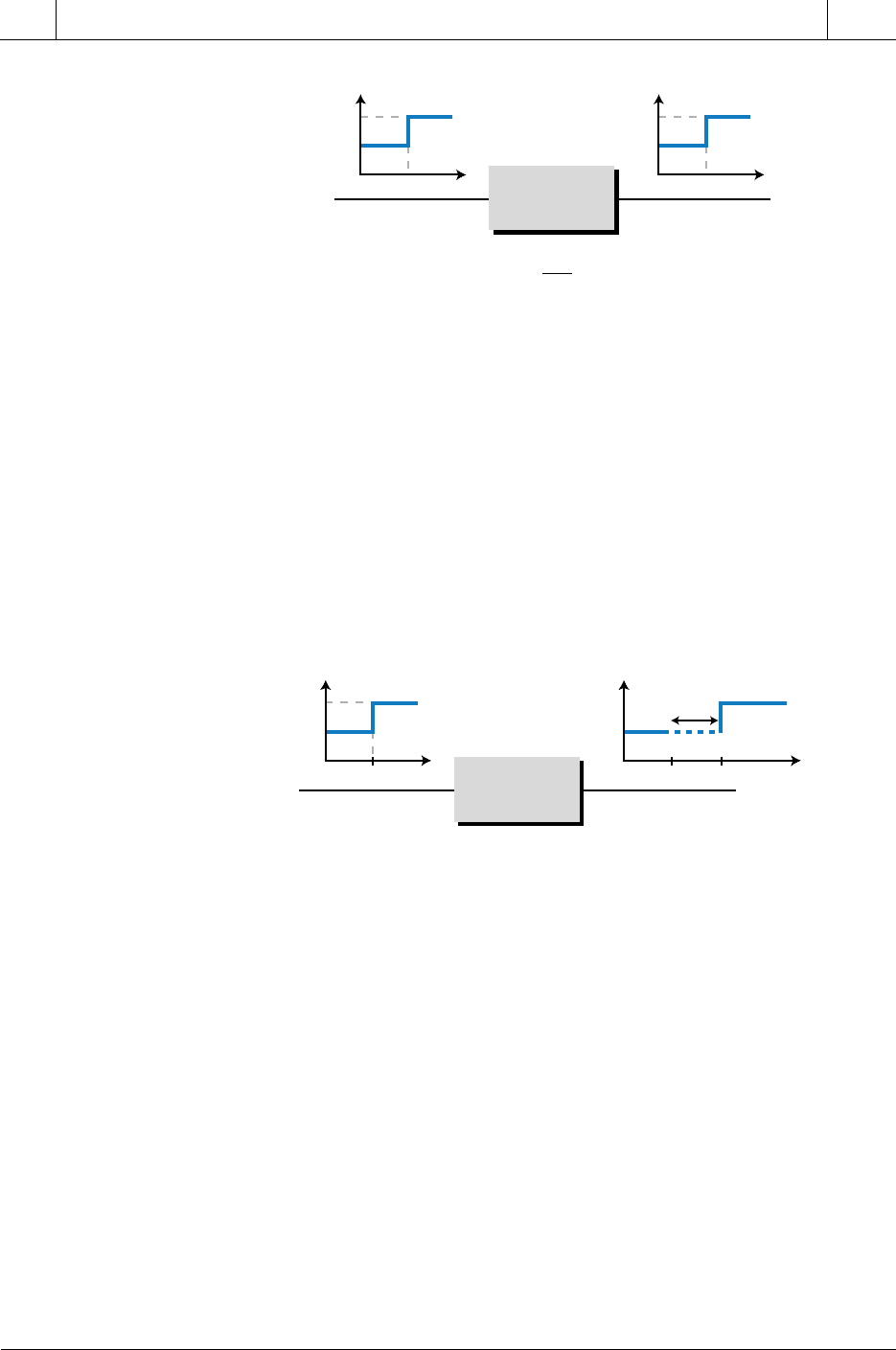
629
CHAPTER
14
Process Responses
and Transfer Functions
Industrial Text & Video Company 1-800-752-8398
www.industrialtext.com
SECTION
4
PLC Process
Applications
Process
PVCV
B
A
t
0
B
A
t
0
Hp
Hp
= = 1
PV
CV
Figure 14-25. Instantaneous response of the process output to a step change in input.
Figure 14-26. Dead time delay.
Process
PVCV
B
A
t
0
B
A
t
0
t
d
Hp
CV PV
Dead Time
reality, however, characteristics distinctive to the process influence the
relationship between the control variable and process variable, resulting in a
transfer function that is not equal to 1. One of these process characteristics is
the inherent delay associated with an output’s response to an input (see
Figure 14-26). This delay is called the dead time. A typical example of dead
time occurs when you first turn on the hot-water knob in the shower. The water
will not become hot until all the cool water runs out of the pipe and the water
from the hot-water heater reaches the shower head. The time that elapses
between turning the knob and receiving the hot water is the dead time.
A dead time delay occurs not only when a control variable input is
introduced into the system, but also when an existing input is increased or
decreased. Figure 14-27 illustrates a trailing-end dead time delay for a
stepped-down input. In this system, a dead time delay occurs between the
decrease of the input and the response of the output to the change in input. In
addition to process dead time delay, sensor measuring devices also introduce
a dead time delay into a system, because a time lapse occurs between the
moment the analog process reading is taken and the moment the voltage or
current value is available at the transmitter’s output (see Figure 14-28).
Although the sensor delay is, for the most part, small in comparison to the
process variable dead time, it is still an important part of the transfer
function because it affects the process. This is especially important in fast-
reacting, closed-loop systems, such as servo motor and other positioning
applications.
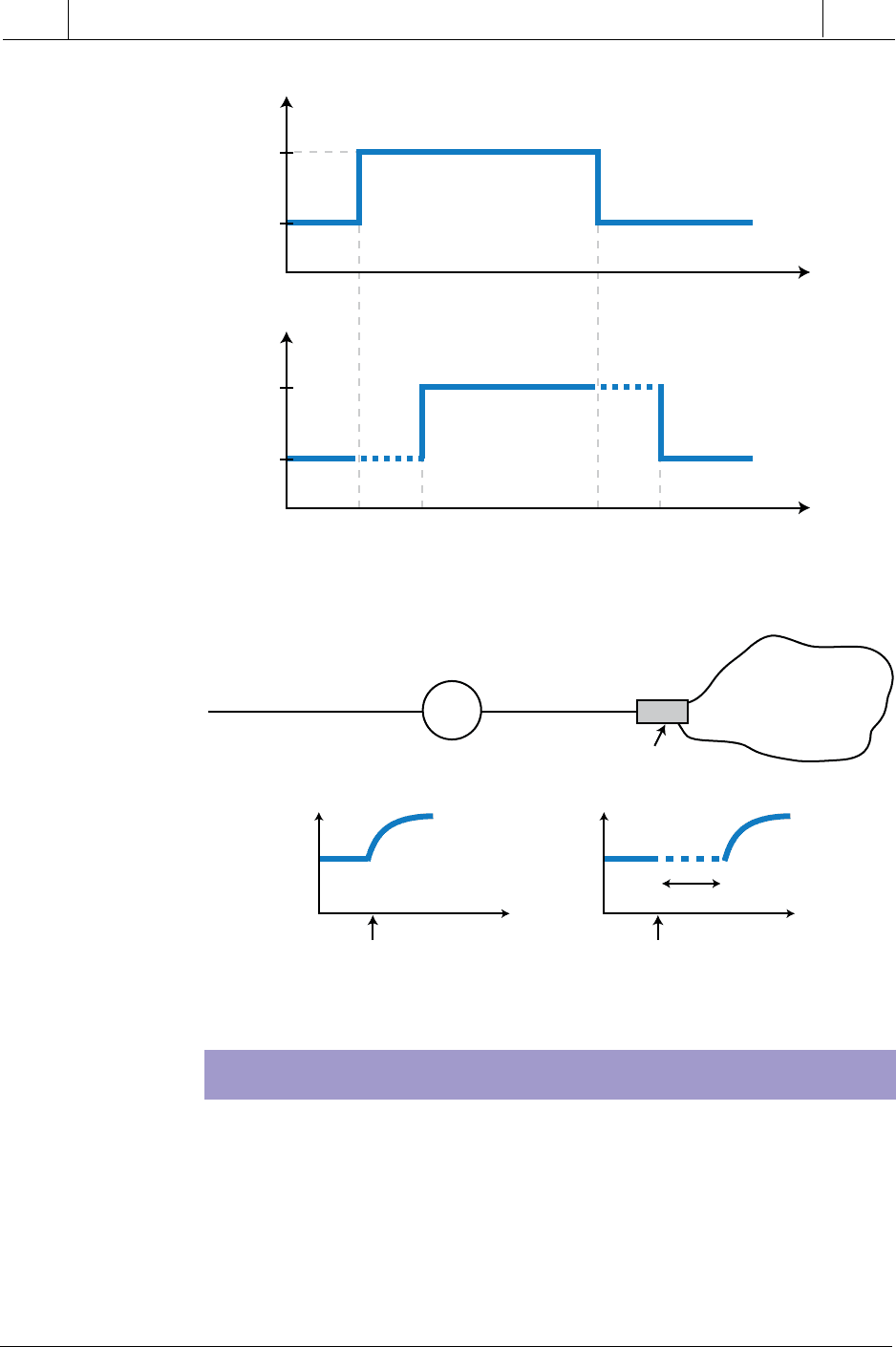
630
SECTION
4
PLC Process
Applications
Industrial Text & Video Company 1-800-752-8398
www.industrialtext.com
CHAPTER
14
Process Responses
and Transfer Functions
Figure 14-28. Sensor dead time delay.
t
d
PV
PV
To Controller
TT
Temperature
Transmitter
Sensor
Temperature °C
Change
Occurs
Dead Time
Delay
Temp
Change
Occurs
Figure 14-27. Trailing-end dead time delay.
A
B
CV
t
A
B
PV
t
t
0
t
d
t
1
t
d
LAG TIME
Dead time is not the only delay associated with a process and its transfer
function. Another delay is lag time. Unlike a dead time delay, which is the
delay between a change in input and the initial response of the process variable
to the input change, a lag time delay occurs when a process variable exhibits
a time lapse between its initial response to the input variable and its optimal
response to it. Lag time occurs due to process characteristics that are
contained in the transfer function. An example of lag time delay can be

631
CHAPTER
14
Process Responses
and Transfer Functions
Industrial Text & Video Company 1-800-752-8398
www.industrialtext.com
SECTION
4
PLC Process
Applications
Figure 14-29. Lag time in a car’s cruise control mechanism.
SP
70 mph
CV
Accelerator
t
t
0
t
1
Disengage Resume
Lag Lag
55 mph
70 mph
55 mph
PV
Speed
t
observed in a car’s cruise control mechanism (see Figure 14-29). If you are
driving at 70 mph under cruise control and disengage the control because you
see a police car, the car’s speed will decrease. Once you pass the police car
and press the cruise control’s resume button, the car will start to accelerate
immediately; however, a delay will occur before the car reaches the set point
speed (70 mph). This delay is the lag time. Note that, in this example, the dead
time is minimal, because once the resume button is pressed, the control
variable (accelerator) increases and the speed (process variable) begins to
react almost immediately.
A process generally has one of two types of lag, which are the result of its
transfer function:
• first-order lag
• second-order lag
First-order lag time is the lag a process variable exhibits in response to a rapid
change in the control variable. Second-order lag time is the oscillating
response of a process variable as it settles to its steady-state value after a
step change in the input. Figure 14-30 illustrates both first- and second-order
lags. Note how the two processes respond differently to the same change in
input because of the different types of lags. A first-order lag is also called a
first-order response, while a second-order lag is called a second-order
response. Both types of responses are called system transient responses.

632
SECTION
4
PLC Process
Applications
Industrial Text & Video Company 1-800-752-8398
www.industrialtext.com
CHAPTER
14
Process Responses
and Transfer Functions
Figure 14-30. First- and second-order lags.
Figure 14-31. Transfer functions in a control system.
Mathematically, transfer functions are expressed through Laplace trans-
forms. Laplace transforms are mathematical functions that are used to solve
complex differential equations by converting them into easy-to-manage
algebraic equations. It is beyond the scope of this book to explain the
14-4 LAPLACE TRANSFORM BASICS
As mentioned previously, the response of a process is tied to the transfer
function of the process itself. Each section of a control system has a transfer
function that can be described mathematically. This includes one transfer
function for the controller, one for the process, and one for the total system
in either an open-loop or closed-loop configuration. As shown in Figure 14-
31, the controller’s transfer function (Hc) is the ratio of its output (CV) to its
input, which is the error between the set point and the process variable. The
process’s transfer function, Hp, is also the ratio of its output (PV) to its
input, the control variable.
Process
First-Order Lag
PVCV
Hp
Process
Second-Order Lag
PVCV
Hp
Controller Process
ESP CV PV
PV
+
–
Σ
Hc
=
Hc Hp
CV
E
Hp
=
PV
CV
Controller’s open-loop
transfer function
Process’s open-loop
transfer function
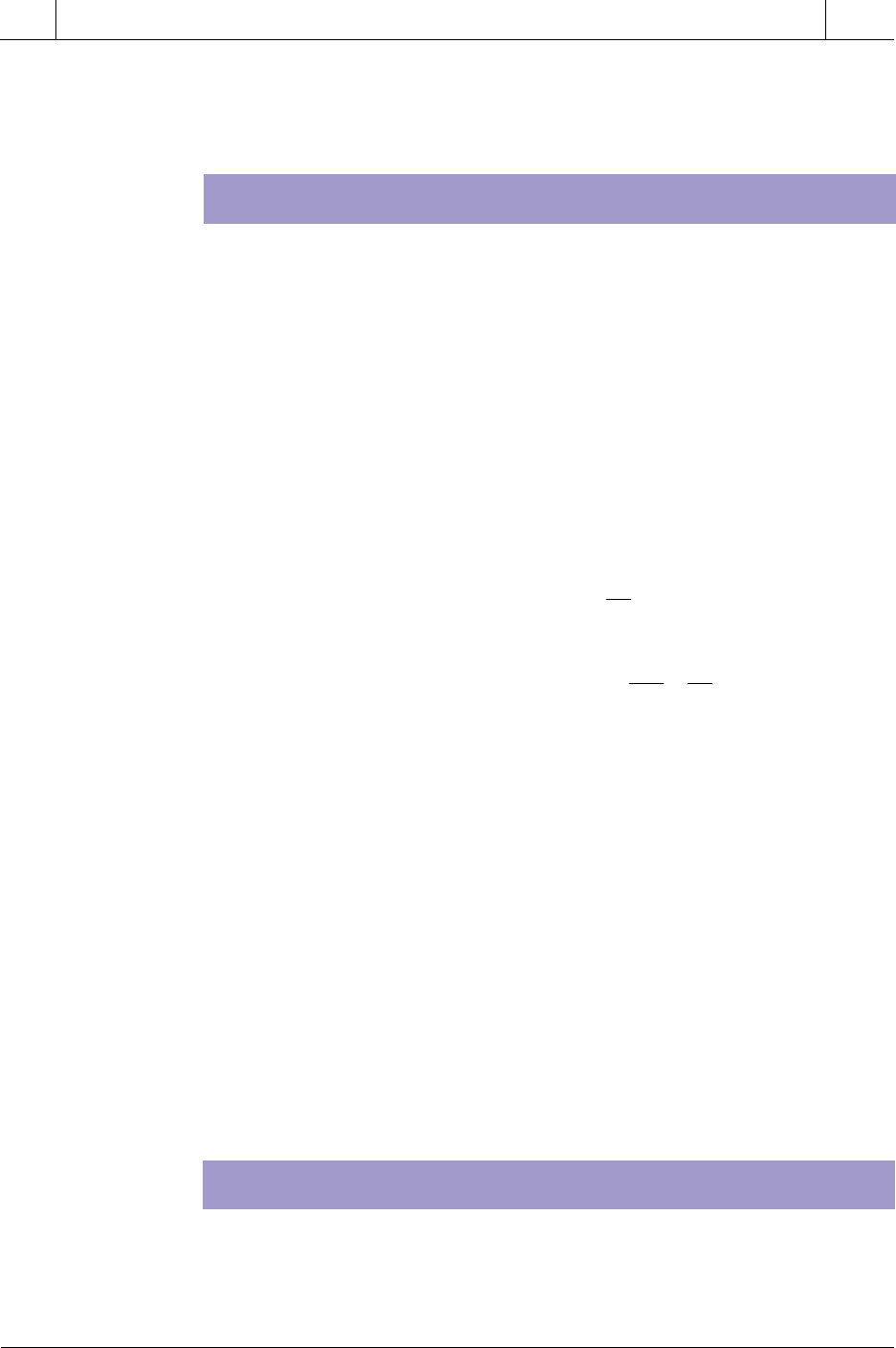
633
CHAPTER
14
Process Responses
and Transfer Functions
Industrial Text & Video Company 1-800-752-8398
www.industrialtext.com
SECTION
4
PLC Process
Applications
mathematical derivation of Laplace transforms. However, we will discuss
how they are used in process control functions, to aid in the understanding
of first- and second-order systems and their transient responses.
TRANSFER FUNCTIONS
As explained earlier, a system can have either a first-order response or a
second-order response. These responses (transfer functions) are expressed as
complex differential equations, with first-order system responses character-
ized by first-order differential equations and second-order systems char-
acterized by second-order differential equations. A first-order differential
equation is a mathematical statement that expresses the rate of change of a
function with respect to its independent variable. A second-order differential
equation expresses the rate of change of a first-order term with respect to its
independent variable (i.e., the rate of change of the rate of change). The
notations used to express first- and second-order differential equations are
as follows:
First-order equation
y
dx
dt
x=+
Second-order equation
y
dx
dt
dx
dt
x=++
2
2
Most control processes found in industrial applications can be described as
either first order or second order. For more complex processes with third-
order responses, a second-order equation can be used to approximate the
process response.
Laplace transforms use known substitutions for complex differential equa-
tions to change them into more easily solvable algebraic equations. To
accomplish this, Laplace transforms convert differential equations from the
time (t) domain—the process response as a function of time—to the fre-
quency (s) domain—the process response as a function of frequency. Table
14-2 shows some of the most common Laplace transforms found in process
control applications. This table also includes inverse Laplace transforms,
which are used to convert Laplace equations back into time domain re-
sponses. Table 14-2 also includes the time domain process responses to a
step input.
DERIVATIVE LAPLACE TRANSFORMS
Laplace transforms replace the derivative terms in both first-order and
second-order differential equations with their respective frequency domain s
terms. Table 14-3 shows the Laplace transforms for both first- and second-
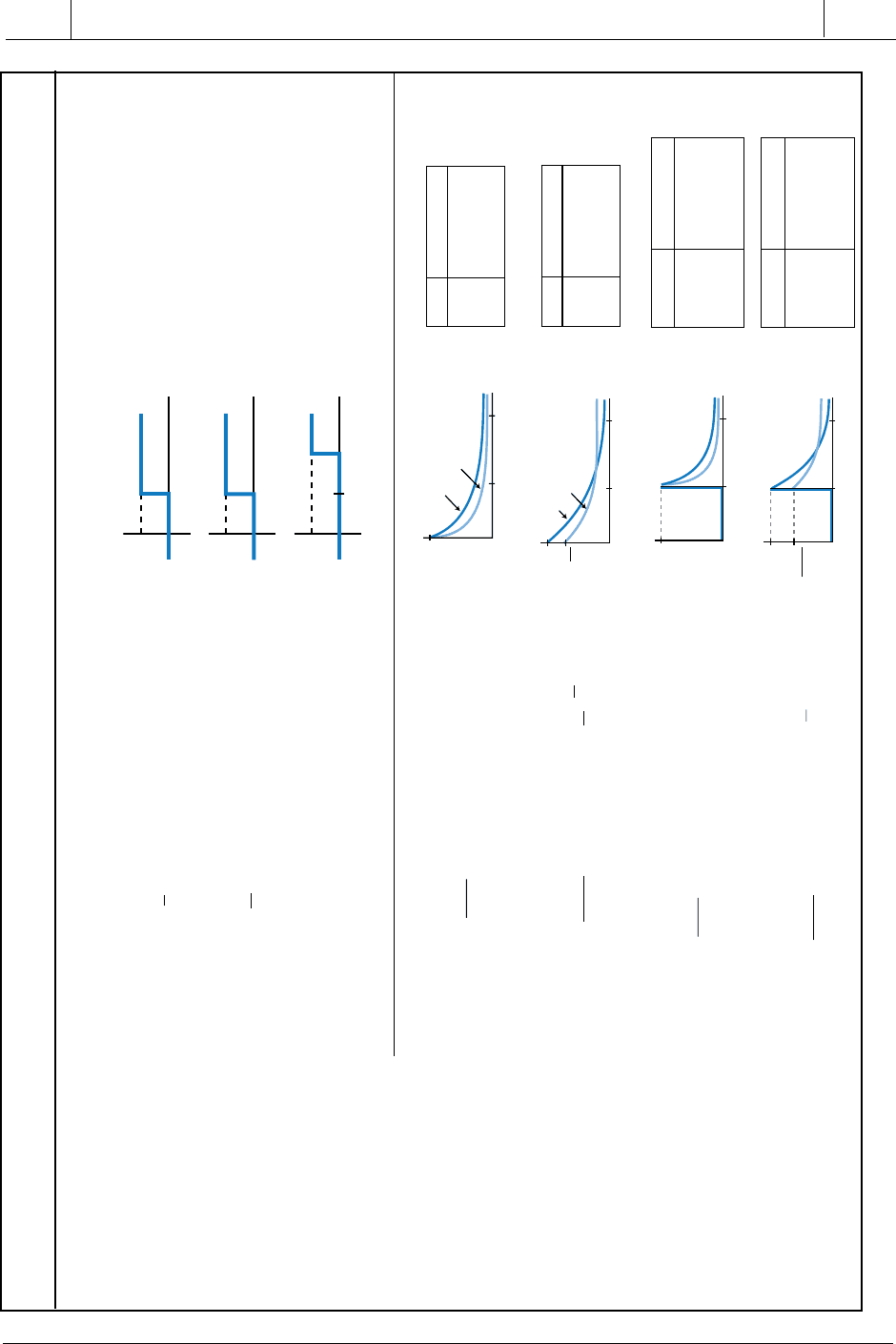
634
SECTION
4
PLC Process
Applications
Industrial Text & Video Company 1-800-752-8398
www.industrialtext.com
CHAPTER
14
Process Responses
and Transfer Functions
First-Order Equations
DESCRIPTION
Any Function
f
Unit Step Input
Step Input
Delay (Dead Time) to
Step Input
First-Order Response
First-Order Response with
Lag
First-Order Response with
Lag plus Dead Time
LAPLACE
TRANSFORM
F
(
s
)
1
s
A
s
Ae
−
t
d
s
A
s
+
a
A
τ
s
+ 1
A
1
A
2
s
+
a
e
−
t
d
s
A
1
A
2
τ
s
+ 1
e
−
t
d
s
TIME
FUNCTION
f
(
t
)
u
(
t
)
A
(
t
)
A
(
t
−
t
d
)
Ae
−
at
A
τ
e
−
t
τ
AAe t t
at
d
12
−
≥for
AAe t t
t
d
12
−
≥
τ
for
A
01 2
t
a
= 1
a
= 2
..
..
..
ττ
==
=
=
=
12
0 1 000 0 500
1 0 368 0 303
2 0 135 0 184
t
t
t
aa
tt
tt
tt
d
d
d
==
=
=+
=+
12
1 000 1 000
1 0 368 0 135
2 0 135 0 018
..
..
..
A
(
t
) = 0
t
<
t
0
A
(
t
) =
At
≥
t
0
u
(
t
) = 0
t
<
t
0
u
(
t
) = 1
t
≥
t
0
A
(
t
−
t
d
) = 0
t
<
t
d
A
(
t
−
t
d
) =
At
≥
t
d
t
0
1
t
0
A
t
0
t
d
A
Table 14-2. Laplace transforms.
PROCESS
RESPONSE
A
A
2
01 2
t
τ
= 1
τ
= 2
A
1
A
2
0
t
d
t
d
+1
t
A
1
A
2
0
t
t
d
t
d
+1
A
1
A
2
2
..
..
..
ττ
==
=
=
=
12
0 1 000 1 000
1 0 368 0 135
2 0 135 0 018
t
t
t
ττ
==
=
=+
=+
12
1 000 0 500
1 0 368 0 135
2 0 135 0 018
tt
tt
tt
d
d
d
..
..
..
For
A
=1
For
A
=1
For
A
1
A
2
=1
For
A
1
A
2
=1
First-Order Response plus
Dead Time
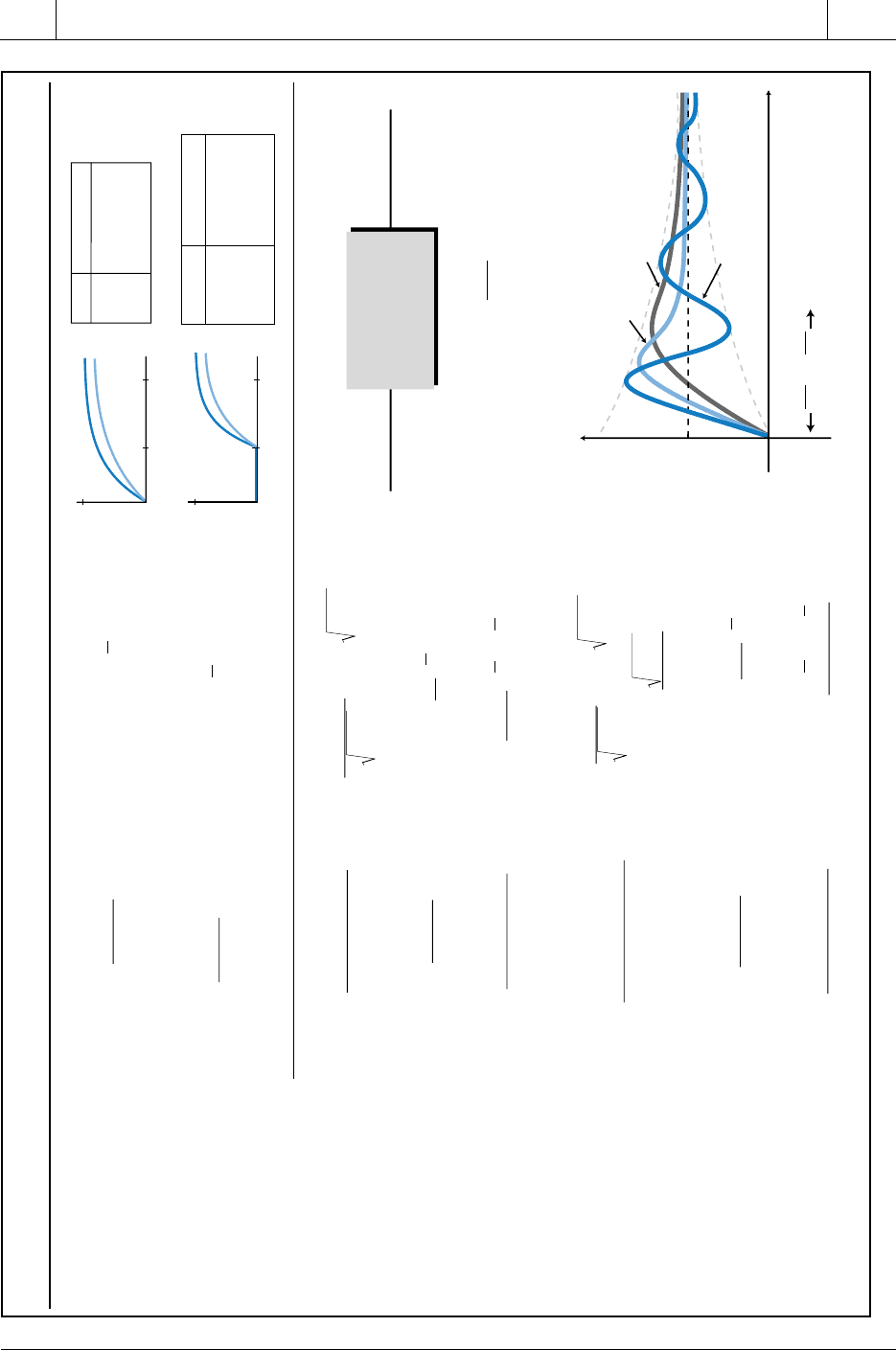
635
CHAPTER
14
Process Responses
and Transfer Functions
Industrial Text & Video Company 1-800-752-8398
www.industrialtext.com
SECTION
4
PLC Process
Applications
DESCRIPTION
LAPLACE
TRANSFORM
TIME
FUNCTION
First-Order Response to Step
Input (
A
1
/
s
) with Lag
AA e
t
12
1()−
−
τ
A
1
A
2
s
(
τ
s
+ 1)
τ
= 1
τ
= 2
t
= 0 0.000 0.000
t
= 1 0.632 0.393
t
= 2 0.865 0.632
First-Order Response to Step Input
(
A
1
/
s
) with Lag plus Dead Time
A
1
A
2
A
3
s
(
τ
s
+ 1)
e
−
t
d
s
AAA e t t
t
d
123
1()−≥
−
τ
for
Second-Order Transfer Function
(
Hp
(
s
)
) for ζ < 1 (Underdamped)
A
ω
n
2
s
2
+ 2
ζω
n
s
+
ω
n
2
Second-Order Transfer Function
(
Hp
(
s
)
) for ζ = 1 (Critically Damped)
A
(
τ
s
+ 1)
2
Second-Order Step Response
(
A
1
/
s
) for ζ = 1 (Critically Damped)
A
1
A
2
1 −
τ
−
t
τ
e
−
t
τ
A
1
A
2
s
(
τ
s
+ 1)
2
Second-Order Step Response
(
A
1
/
s
) for ζ > 1 (Overdamped)
AA
ee
tt
12
12
21
1
22
+
−
−
−−
ττ
ττ
τ
τ
A
1
A
2
s
(
τ
1
s
+ 1)(
τ
2
s
+ 1)
Second-Order Step Response
(
A
1
/
s
) for ζ < 1 (Underdamped)
A
1
A
2
ω
n
2
s
(
s
2
+ 2
ζω
n
s
+
ω
n
2
)
A
1
A
2
1 +
e
−
ζω
n
t
1−
ζ
2
sin
ω
n
1−
ζ
2
t
−
ψ
where
ψ
= tan
−1
1−
ζ
2
−
ζ
(0 <
ψ
<
π
)
Second-Order Equations
At
τ
2
e
−
t
τ
Second-Order Transfer Function
(
Hp
(
s
)
) for ζ > 1 (Overdamped)
A
τ
1
−
τ
2
(
e
−
t
τ
1
−
e
−
t
τ
2
)
A
(
τ
1
s
+ 1)(
τ
2
s
+ 1)
A
ω
n
e
−
ζω
n
t
1−
ζ
2
sin
ω
n
1−
ζ
2
t
Table 14-2 continued.
PROCESS
RESPONSE
A
1
A
2
A
3
0
t
t
d
t
d
+1
A
1
A
2
01 2
t
In Out
Out
In
Hp
(s)
Hp
(s)
=
2π
ω
n
1
f
n
or
A
1
A
2
Underdamped ζ < 1
Overdamped ζ > 1
Critically damped ζ = 1
t
ττ
==
=
=+
=+
12
1 000 1 000
1 0 632 0 393
2 0 865 0 632
tt
tt
tt
d
d
d
..
..
..
For
A
1
A
2
=1
For
A
1
A
2
A
3
=1
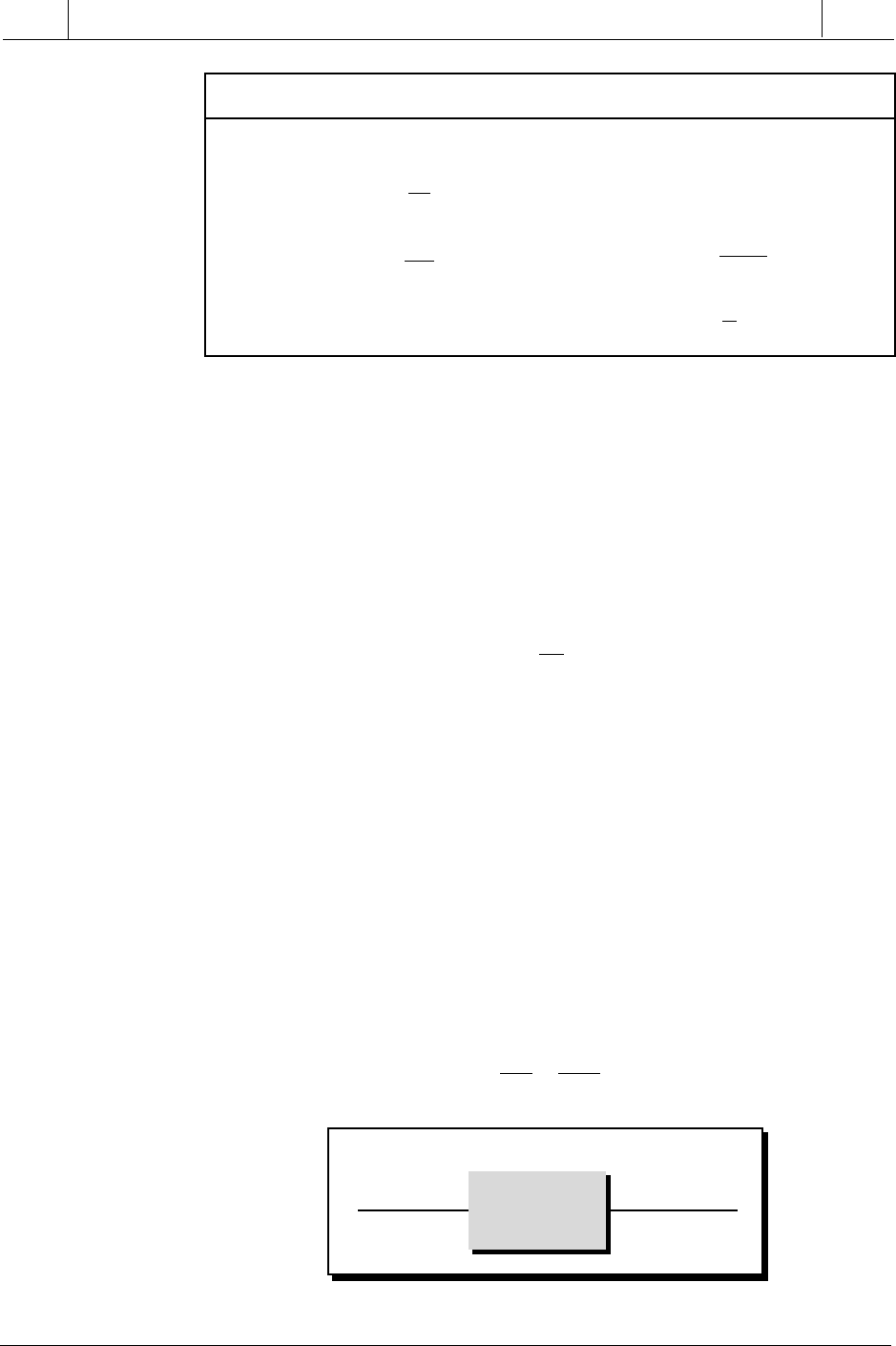
636
SECTION
4
PLC Process
Applications
Industrial Text & Video Company 1-800-752-8398
www.industrialtext.com
CHAPTER
14
Process Responses
and Transfer Functions
Table 14-3. Derivative Laplace transforms.
Input Output
Hp
Y
(s)
X
(s)
Process
Figure 14-32. Process inputs and outputs in Laplace form.
order derivative terms. In the frequency domain, a first-order derivative term
becomes an s term times the function in the frequency domain minus a
constant, which is the value of the function at t = 0 in the time domain. A
second-order derivative becomes an s
2
Laplace term times the Laplace
function minus s times the value of the time domain first derivative at t = 0
minus the value of the function at t = 0 in the time domain. Therefore, a
simple first-order differential equation of the form:
y
dx
dt
x
tt() ()
=+
becomes the following equation in Laplace form:
YsXx X
sst s() () ( ) ()
=−+
=0
Assuming that the value of the function x
(t = 0)
is zero, the equation becomes:
YsXX
Xs
sss
s
() () ()
()
()
=+
=+1
If X
(s)
represents the Laplace output of the process and Y
(s)
represents the input,
as shown in Figure 14-32, the equation for the transfer function of the
process (output divided by input) in Laplace form becomes:
X
Ys
s
s
()
()
=
+
1
1
Function
x
(
t
)
X
(
s
)
Second
Derivative
Integral
Time (
t
) Domain Laplace (
s
) Domain
First
Derivative
dx
dt
sX
(
s
)
–
x
(
t
= 0)
dx
dt
2
2
Adt
t
0
∫
A
s
sX s
dx
dt
x
s
t
t
2
0
0()
()
()
−−
=
=

637
CHAPTER
14
Process Responses
and Transfer Functions
Industrial Text & Video Company 1-800-752-8398
www.industrialtext.com
SECTION
4
PLC Process
Applications
This indicates that the Laplace output X
(s)
is equal to the Laplace input times
the transfer function in Laplace form:
XY
s
ss() ()
=
+
1
1
So, by working in the frequency domain instead of the time domain, the
solving of the differential equation is reduced to an algebraic manipulation.
In the Laplace domain, the exponent of the s term indicates the order of the
transfer function—in this case, a first-order transfer function.
A second-order differential equation of the form:
y
dx
dt
dx
dt
x
tt() ()
=++
2
2
becomes the following equation in Laplace form:
YsXs
dx
dt
xsXxX
ss
t
tsts() ()
()
() () () ()
=− −
+−
[]
+
=
==
2
0
00
Assuming that the values of the initial parameters are zero, this equation
becomes:
YsXsXX
Xs s
ssss
s
() () () ()
()
=++
=++
()
2
2
1
Since Y
(s)
represents the input and X
(s)
represents the output, the transfer
function for a second-order response in Laplace form is:
X
Yss
s
s
()
()
=
++
()
1
1
2
Note that the exponent of the s term indicates a second-order transfer function.
As a result of the different mathematical formats of first-order and second-
order transfer functions, a second-order system will have an oscillating
response, while a first-order system will have a smooth response toward its
final steady-state value. We will discuss these response curves in more detail later.
The substitutions used in Laplace transforms are the result of computations
performed on electrical circuit networks (e.g., resistors, capacitors, and
inductors) that create transfer functions. Mechanical and hydraulic systems
also use Laplace transforms to represent system transfer functions, primarily
because of their similarity in mathematical representation to electrical sys-
tems. The following example illustrates the derivation of a transfer function
for a resistor/capacitor (R/C) network.

638
SECTION
4
PLC Process
Applications
Industrial Text & Video Company 1-800-752-8398
www.industrialtext.com
CHAPTER
14
Process Responses
and Transfer Functions
Figure 14-33. R/C electrical network diagram.
EXAMPLE 14-3
Figure 14-33 represents an R/C (resistor/capacitor) electrical network.
Find (a) the differential equation that represents this network, (b) the
network transfer function in Laplace, and (c) the equivalent closed-
loop block diagram. Refer to Appendix G for information about the
characteristics of electrical circuit elements.
S
OLUTION
The term
V
C
represents the voltage across the capacitor (
C
). This term
is equivalent to
V
out
and is represented by:
VV
C
idt
C
t
out
==
∫
1
0
Kirchhoff’s voltage law states that the voltage at the output of an
electrical circuit is equal to the input voltage minus the voltage across
the resistor (
V
R
), which is equal to the current (
i
) times the resistance
(
R
). Therefore:
VVV
ViR
R
out in
in
=−
=−
Solving for the current yields:
VViR
iR V V
iVV
R
out in
in out
in out
=−
=−
=−
(
)
1
Replacing the current term in the capacitor’s output voltage equation
with this value of
i
produces:
V
out
V
in
C
R
current
i
i
= current
